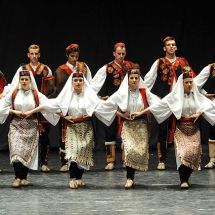In addition to its 8 UNESCO World Heritage Sites, Croatia has a wealth of intangible UNESCO heritage. In a new series on TCN on September 21, 2016, Filipa Marusic takes a closer look, beginning with the Silent Circle dance of inland Dalmatia.
This is a specific regional dance where each dancer dances his own steps by jumping in a closed circle or in couples. This intangible heritage was inscribed in the UNESCO list in 2011. The main difference between the Silent Circle dance and other traditional dances is there is no music but the rhythm is set by the steps of the dancers.
The most important role is that of the main dancer called the kolovođa. The main movement is energetically jumping from one leg to another while male dancers lead female partners. The dance has both slow and fast dance moves and jumps – they all have the aim of showing the strength and talent of the dancers involved. This makes sense if you know the traditional outfit for the Silent Circle dance weights up to 7 kg.
The dance seems not to have set rules, but for the locals the specific way of performing was the tool to distinguish different villages in the inland. Apart from the name “Silent Circle“ (Nijemo Kolo in Croatian) there are regional variations to the name or specific dances named after region from where it comes from. It is almost always danced without any accompanying music but it can be performed while singing specific voice shaking techniques (ganga, reara, ojkavica) or playing traditional instruments (dipla or mijeh which are form of bagpipes). Usually music part is before or as a follow up to the dance.

The Silent Circle is supported by local authorities and government as something worth preserving and it is essential part of cultural clubs and local dance groups who practice it and present it to the public. This dance is often performed in the region of Vrlika as well as Sinj and the Gata region. From Vrlika region there is a locally famous operetta 'Ero s onog svijeta' which incorporated parts of Silent Circle dance. The Silent Circle is performed throughout whole Dalmatian inland on local fairs and festivities, weddings and carnivals. Before it was widespread among Dalmatian inland villages, today it can be usually seen as part of local folklore groups. This dance is passed on from generation to generation – during history this was done spontaneously while nowadays it is more kept in local cultural associations. A good example of preserving the heritage can be local folklore groups such as KUD Filip Dević or KUD Jedinstvo in Split. Both are open for new members and are eager to teach old traditional dances. Anyone who wants to learn this UNESCO protected dance, but also other regional dances should contact Jedinstvo or Filip Devic to sign up for dancing lessons.
Source: Ministry of Culture, KUD Jedinstvo, KUD Filip Dević


